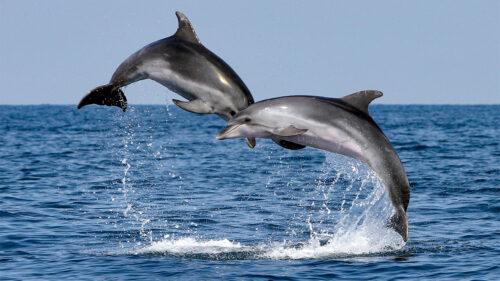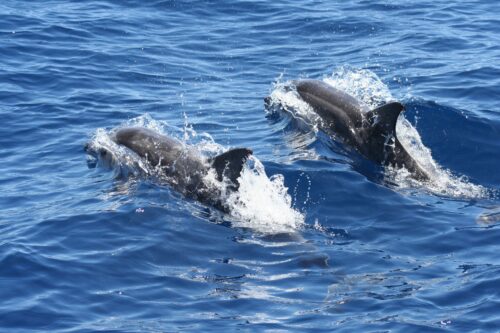Did you know that some dolphins are pink? Or that the killer whale is actually a type of dolphin? These remarkable marine mammals are full of surprises, and we’re just getting started!
From the shallow waters of tropical oceans to the mysterious freshwater domains of the Amazon River, dolphins inhabit a vibrant world that’s waiting to be explored.
With over 40 diverse species, fascinating communication methods, and unique social behaviors, dolphins are far from ordinary.
Get ready to dive into an adventure filled with delightful facts and intriguing discoveries about these captivating creatures!
Click the link to learn all about snorkeling tours on Oahu where you may see some dolphins!
Fact 1: Dolphins Are Global Citizens
Dolphins are truly global citizens of the oceans! From the warm waters of the Caribbean Sea, where you might spot playful bottlenose dolphins, to the waters off the coast of New Zealand, where dusky dolphins reside, these marine mammals are found almost everywhere.
You’ll discover different species of dolphins inhabiting both tropical oceans and temperate waters, making them among the most widely distributed marine life on Earth.
Even in far-reaching places like the Amazon River, you can find unique river dolphins showcasing their incredible adaptability!
Fact 2: Whales or Dolphins? A Surprise!
It might come as a surprise, but not all “whales” are actually whales. The killer whale, for example, is a member of the dolphin family.
Despite its intimidating name and size, the killer whale is the largest species of dolphin, making it a unique and fascinating creature.
Often found in dolphin pods, killer whales have been known to work together in hunting, exhibiting complex social behaviors. So, the next time you hear about a killer whale, remember—it’s a dolphin in disguise!
Fact 3: There Are Unique Freshwater Dolphins
When we think of dolphins, the open ocean usually comes to mind. Yet, did you know that some dolphin species have made rivers their home?
Freshwater dolphins, such as those found in the Amazon and Ganges Rivers, are remarkable examples of adaptability.
These fascinating dolphin species have unique features that set them apart from their saltwater cousins.
River dolphins often have longer snouts and flexible necks, allowing them to navigate rivers’ murky and narrow channels. Of course, let’s not forget that some of them are pink!
Fact 4: They Have Odd Eating Habits
Dolphins have a rather unique and practical approach to dining. Unlike other fish, dolphins will often swallow their prey head first.
Why? It’s all about the spines! Dolphins ensure that the fish’s spines don’t catch in their throat by swallowing a fish head first.
Their diet primarily consists of pounds of fish, squid, and other food sources from the temperate ocean. These marine mammals are skilled hunters, using their echolocation skills to locate prey even in murky or dark water.
Fact 5: Multiple Stomachs, One Dolphin
Ever wondered about the digestive system of a dolphin? It’s more complex than you might think! Dolphins have more than one stomach, similar to some other land mammals.
Their first stomach stores food, while the others break it down.
This unique food storage system allows dolphins to quickly consume a large amount of food, which is crucial when hunting in the wild. Bottlenose dolphins, for example, can eat up to 20 pounds of fish a day!
Fact 6: Dolphins Love Bubbles
If you’ve ever watched dolphins at play, you might have noticed their love for blowing bubbles. It’s more than just a playful act; it’s a part of their communication and hunting techniques.
Some dolphins use bubbles to herd fish, creating a barrier that guides their prey into a concentrated area. They’ll often mess with people who are scuba diving in Hawaii because their BCD’s will blow off bubbles.
Bottlenose dolphins, known for their playful nature, often blow bubble rings and swim through them, turning a hunting technique into a game!
Their affinity for bubbles adds a touch of whimsy to these marine mammals, making them one of the most endearing and engaging species in the animal kingdom.
Fact 7: They’re Friendly and Chatty Creatures
Dolphins are renowned for being incredibly social animals. Whether it’s in pods of dolphins or smaller family groups, they often engage in complex social behaviors, using body language and special whistles to communicate.
Each dolphin has a signature whistle, like a name, allowing them to call out to one another and maintain strong social bonds.
From wild dolphins to those in captivity, this form of communication is universal in the dolphin family. People doing dolphin tours in Hawaii may often hear these sounds.
Bottlenose dolphins, common dolphins, and other dolphin species also display friendliness towards humans, often approaching boats and engaging in playful activities.
Fact 8: Dolphins Can Get Pretty Old
Dolphins are known for their relatively long lives, especially when compared to other marine mammals.
The average life span of a dolphin can range from 20 to 50 years, depending on the species and environment.
For example, common bottlenose dolphins often live up to 40 or even 50 years in the wild. Female dolphins tend to live longer than males, making them one of the more fascinating aspects of the dolphin family.
Fact 9: Dolphins Sleep Only With One Eye Closed
Dolphins have a unique way of resting that might seem bizarre to land mammals like us. Unlike humans, dolphins sleep with one-half of their brain awake and one eye open! We saw this happen on a tour we went on in Oahu, it was extraordinary!
This incredible adaptation allows them to continue swimming, maintain body temperature, and even be alert to potential predators while the other half of their brain rests.
In shallow waters or when close to the surface, this method of “unihemispheric sleep” ensures that they can come up for air as needed, even when half-asleep.
Fact 10: They’re Super Smart
Dolphins are often celebrated for their intelligence, and rightly so! These intelligent creatures display problem-solving skills, self-awareness, and a capacity to learn new tasks.
Bottlenose dolphins, for example, have been studied extensively for their impressive cognitive abilities.
They use tools like marine sponges to protect their rostrums while foraging on the seafloor and have even been observed teaching these skills to their dolphin calves.
Waving Goodbye to Our Flippered Friends
From their playful antics in tropical oceans to their exceptional intelligence and unique ways of sleeping, dolphins never cease to amaze.
Whether it’s the bottlenose dolphins with their witty antics or the rare freshwater species in the Amazon and Ganges Rivers, these marine mammals hold a special place in our hearts and minds!
Social connections, essential roles in the food chain, and more—these fun facts about dolphins always spark our curiosity. We can’t help but be enchanted by these amazing creatures!
